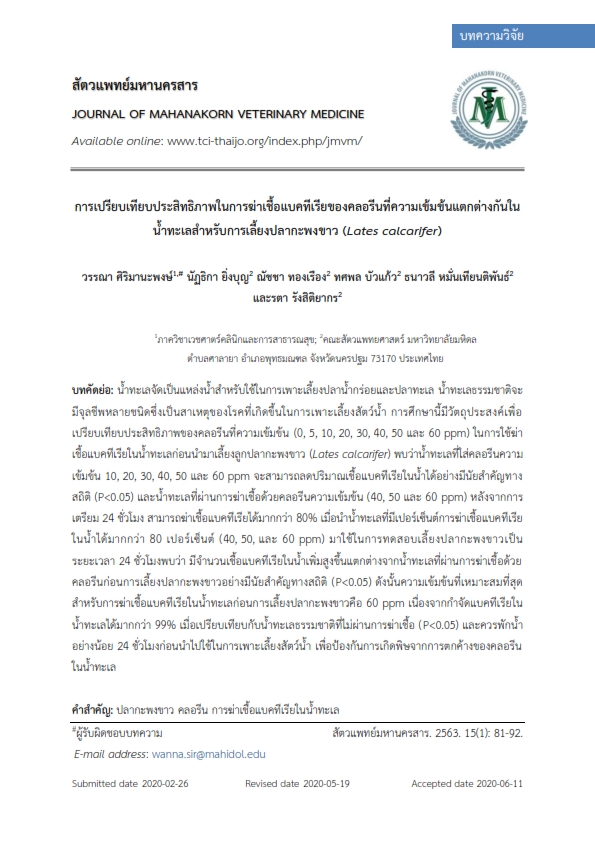Comparing the Bactericidal Effect of Different Chlorine Concentrations in Seawater for Giant perch (Lates calcarifer) Culturing
Main Article Content
Abstract
Seawater is generally resource of water for brackish or marine fish aquaculture. The natural seawater composed of many microorganism’s cause of disease in aquaculture. This study aimed to compare efficiency of chlorine at various concentrations (0, 5, 10, 20, 30, 40, 50 and 60 ppm) to kill bacteria in seawater before culturing fingering giant perch (Lates calcarifer). The amount of bacteria in the seawater were significantly reduce in 10, 20, 30, 40, 50 and 60 ppm of chlorine concentrations (P<0.05). Moreover, 80% bactericidal effect was found in the treated seawater at 40, 50 and 60 ppm after 24 hours of water preparation. The effective bactericidal concentration (40, 50 and 60 ppm) of the seawater was used for culturing fingering giant perch for 24 hours. After 24 hours of fish culturing, the number of bacteria increased in the chlorine treated group when compared to the treated seawater before fish culturing (P<0.05). Therefore, the optimal concentration for killing bacteria in seawater before culturing giant perch was 60 ppm when compared to the number of bacteria in the untreated natural seawater with significantly different (P<0.05). Since, it eliminated more than 99% bacteria in the seawater. More than 24 hours treated seawater should be consideration for culturing giant perch to prevent chlorine toxicity.
Article Details
References
Arimoto, M., J. Sato, K. Maruyama, G. Mimura, and I. Furusawa. 1996. Effect of chemical and physical treatments on the inactivation of striped jack nervous necrosis virus (SJNNV). Aquaculture. 143(1): 15-22.
Austin, B. 1988. Marine microbiology. Cambridge university press: New York, USA. p. 1-8.
Benarde, M. A., W. B. Snow, V. P. Olivieri, and B. Davidson. 1967. Kinetics and mechanism of bacterial disinfection by chlorine dioxide. Appl. Environ. Microbiol. 15(2): 257-265.
Boyette, M. D., D. F. Ritchie, S. J. Carballo, S. M. Blankenship, and D. C. Sanders. 1993. Chlorination and postharvest disease control. Horttechnology. 3(4): 395-400.
Bullock, G. L., S. T. Summerfelt, A. C. Noble, A. L. Weber, M. D. Durant, and J. A. Hankins. 1997. Ozonation of a recirculating rainbow trout culture system I. Effects on bacterial gill disease and heterotrophic bacteria. Aquaculture. 158(1-2): 43-55.
Chang, P. S., L. J. Chen, and Y. C. Wang. 1998. The effect of ultraviolet irradiation, heat, pH, ozone, salinity and chemical disinfectants on the infectivity of white spot syndrome baculovirus. Aquaculture. 166(1-2): 1-17.
Egidius, E. 1987. Vibriosis: pathogenicity and pathology, A review. Aquaculture. 67: 15-28.
Frerichs, G., A. Tweedie, W. Starkey, and R. Richards. 2000. Temperature, pH and electrolyte sensitivity, and heat, UV and disinfectant inactivation of sea bass (Dicentrarchus labrax) neuropathy nodavirus. Aquaculture. 185(1-2): 13-24.
Huang, J., L. Wang, N. Ren, and F. Ma. 1997. Disinfection effect of chlorine dioxide on bacteria in water. Water Res. 31(3): 607-613.
Kungvankij, P., L. B. Tiro Jr, B. J. Pudadera Jr, and I. O. Potestas. 1986. Biology and culture of sea bass (Lates calcarifer). Network of Aquaculture Centers in Asia. Seafdec. p. 12-15.
Lafferty, K. D., C. D. Harvell, J. M. Conrad, C. S. Friedman, M. L. Kent, A. M. Kuris, E. N. Powell, D. Rondeau, and S. M. Saksida. 2015. Infectious diseases affect marine fisheries and aquaculture economics. Annu. Rev. Mar. Sci. 7: 471-496.
Liltved, H., and S. Cripps. 1999. Removal of particle-associated bacteria by prefiltration and ultraviolet irradiation. Aquac Res. 30(6): 445-450.
Liltved, H., H. Hektoen, and H. Efraimsen. 1995. Inactivation of bacterial and viral fish pathogens by ozonation or UV irradiation in water of different salinity. Aquacult. Eng. 14(2): 107-122.
Martinez-Picado, J., M. Alsina, A. R. Blanch, M. Cerda, and J. Jofre. 1996. Species-specific detection of Vibrio anguillarum in marine aquaculture environments by selective culture and DNA Hybridization. Appl. Environ. Microbiol. 62(2): 443-449.
Petrucci, G., and M. Rosellini. 2005. Chlorine dioxide in seawater for fouling control and post-disinfection in potable waterworks. Desalination. 182(1-3): 283-291.
Puente, M. E., F. Vega-Villasante, G. Holguin, and Y. Bashan. 1992. Susceptibility of the brine shrimp Artemia and its pathogen Vibrio parahaemolyticus to chlorine dioxide in contaminated sea-water. J. Appl. Bacteriol. 73(6): 465-471.
Reilly, A., and F. Käferstein. 1997. Food safety hazards and the application of the principles of the hazard analysis and critical control point (HACCP) system for their control in aquaculture production. Aquac. Res. 28(10): 735-752.
Sudthongkong, C., M. Miyata, and T. Miyazaki. 2002. Iridovirus disease in two ornamental tropical fresh-water fishes: African lampeye and dwarf gourami. Dis. Aquat. Organ. 48(3): 163-173.
Suttle, C. A. 2007. Marine viruses-major players in the global ecosystem. Nat. Rev. Microbiol. 5(10): 801-812.
Whipple, M., and J. Rohovec. 1994. The effect of heat and low pH on selected viral and bacterial fish pathogens. Aquaculture. 123(3-4): 179-189.
Yanong, R. P., and C. Erlacher-Reid. 2012. Biosecurity in aquaculture, part 1: an overview. SRAC Publication No 4707. Stoneville (MS): Southern Regional Aquaculture Center. http://fisheries.tamu.edu/files/2013/09/SRAC-Publication-No.-4707-Biosecurity-in-Aquaculture-Part-1-An-Overview.pdf (Accessed 1 January 2020)


